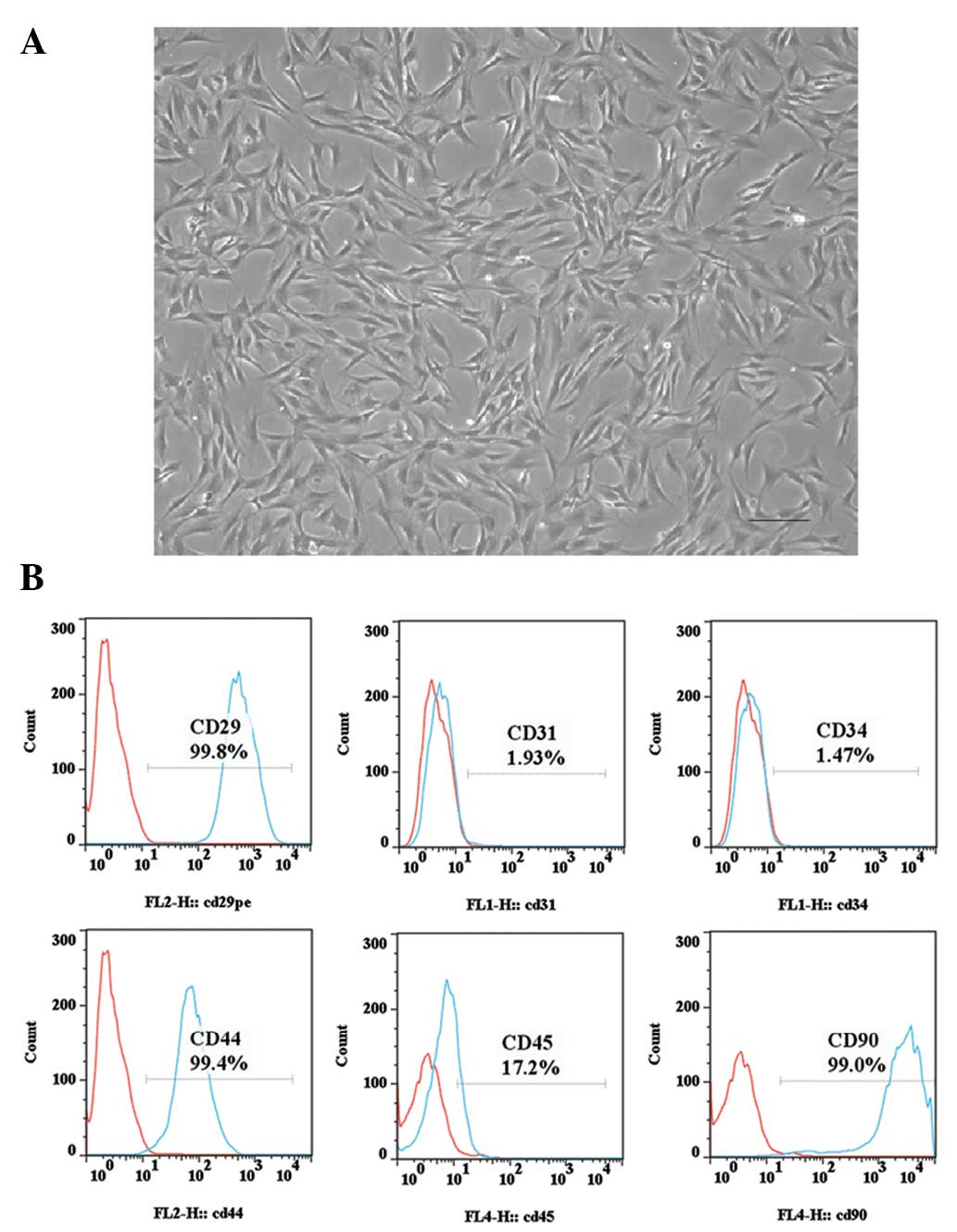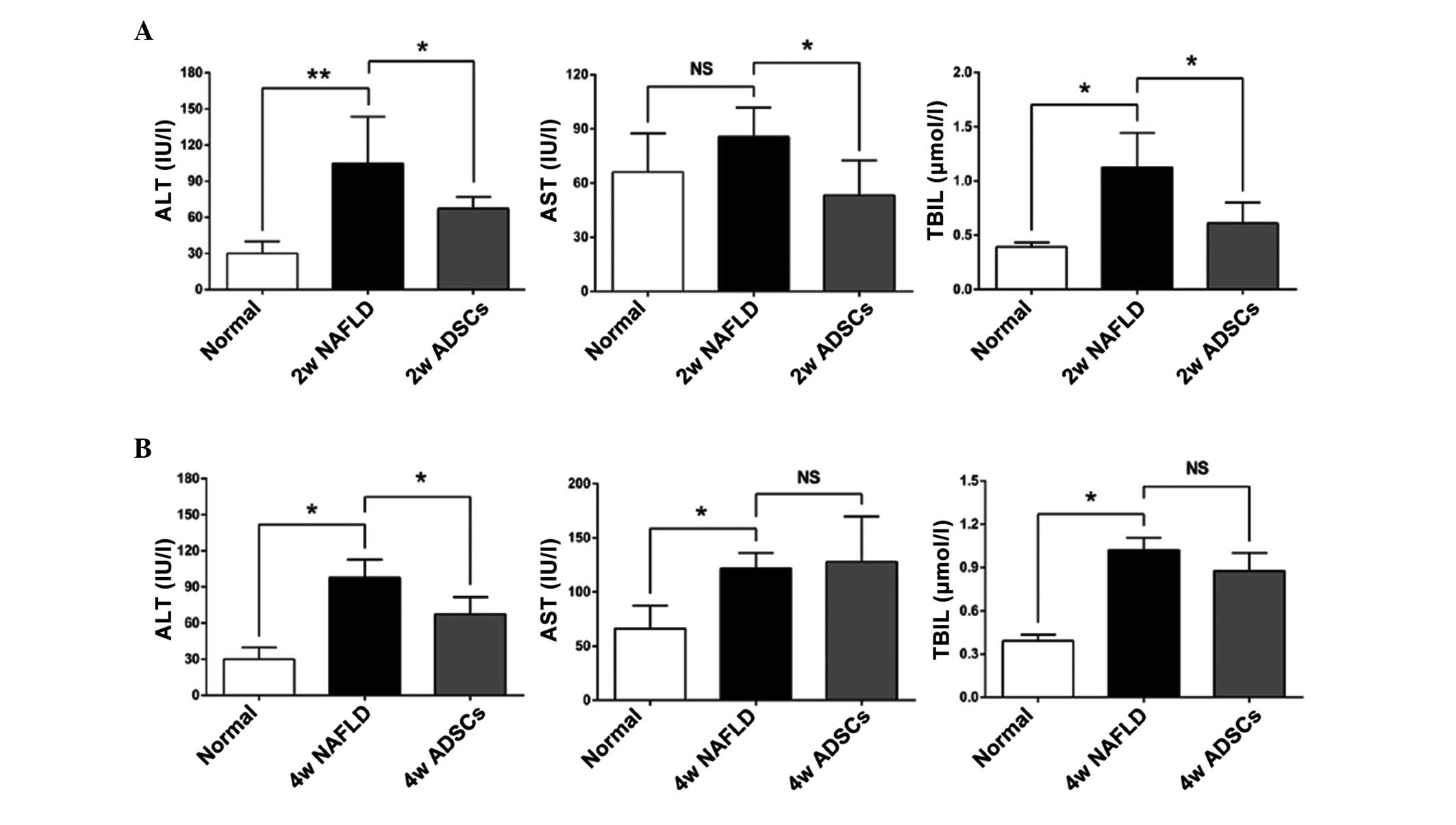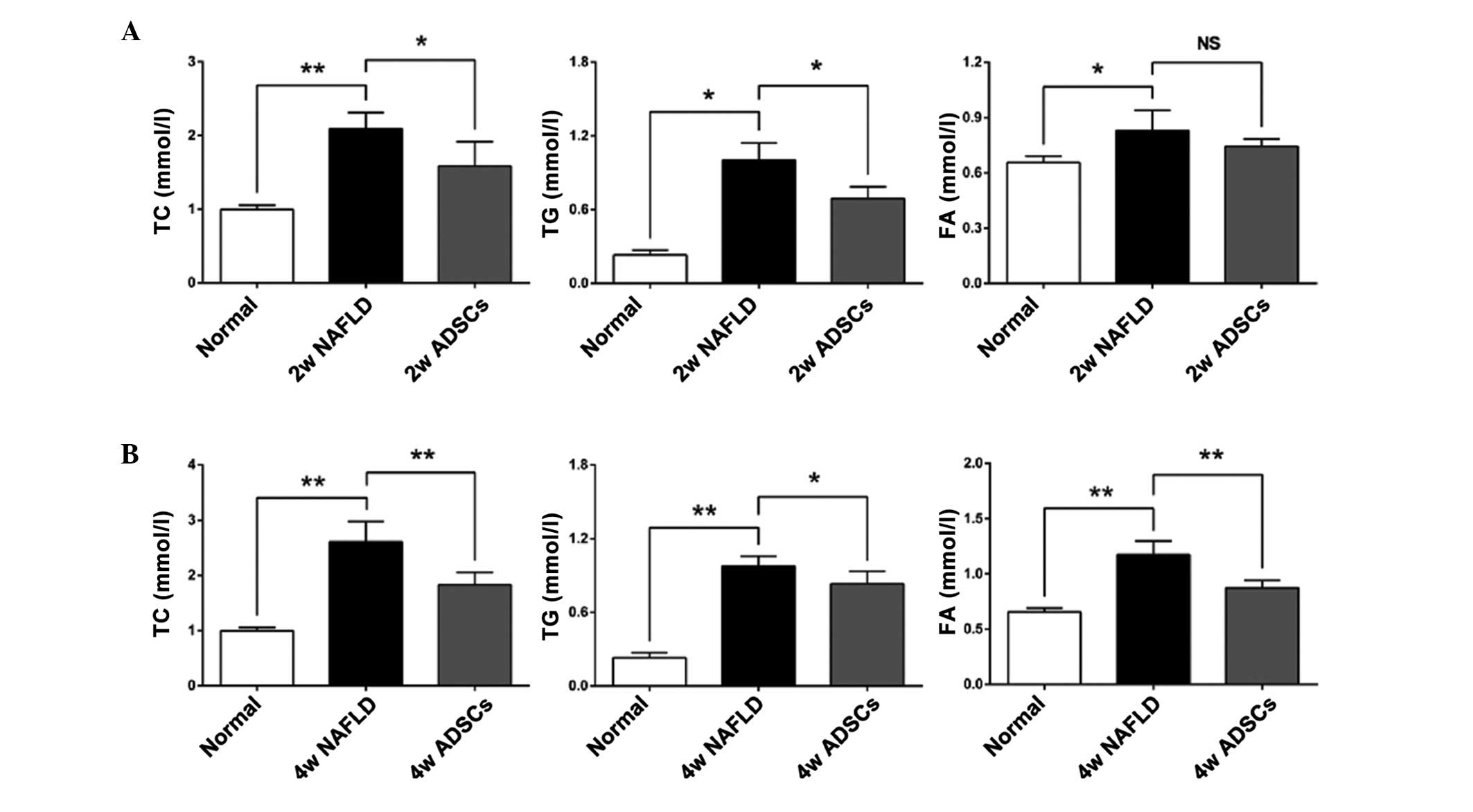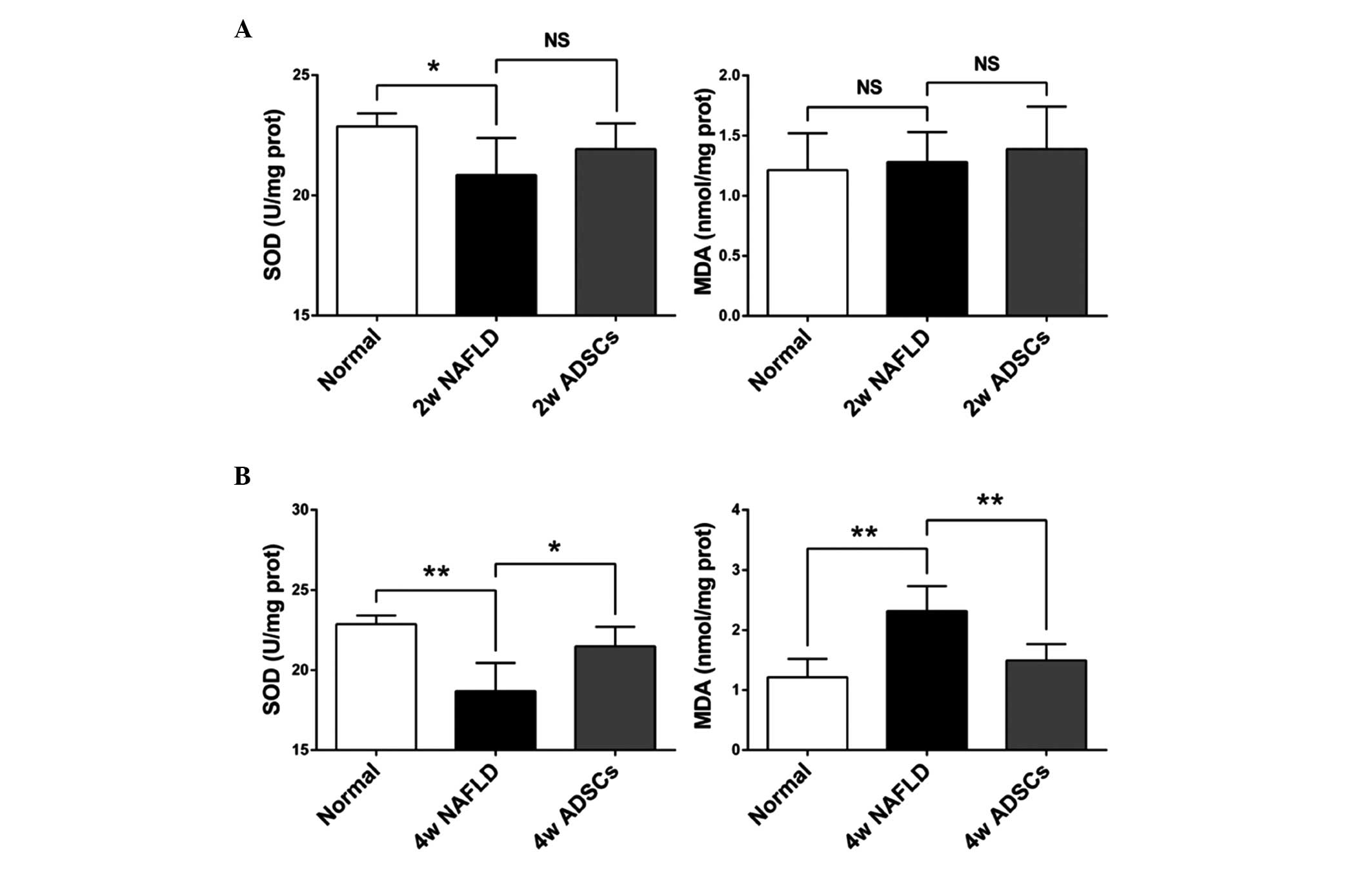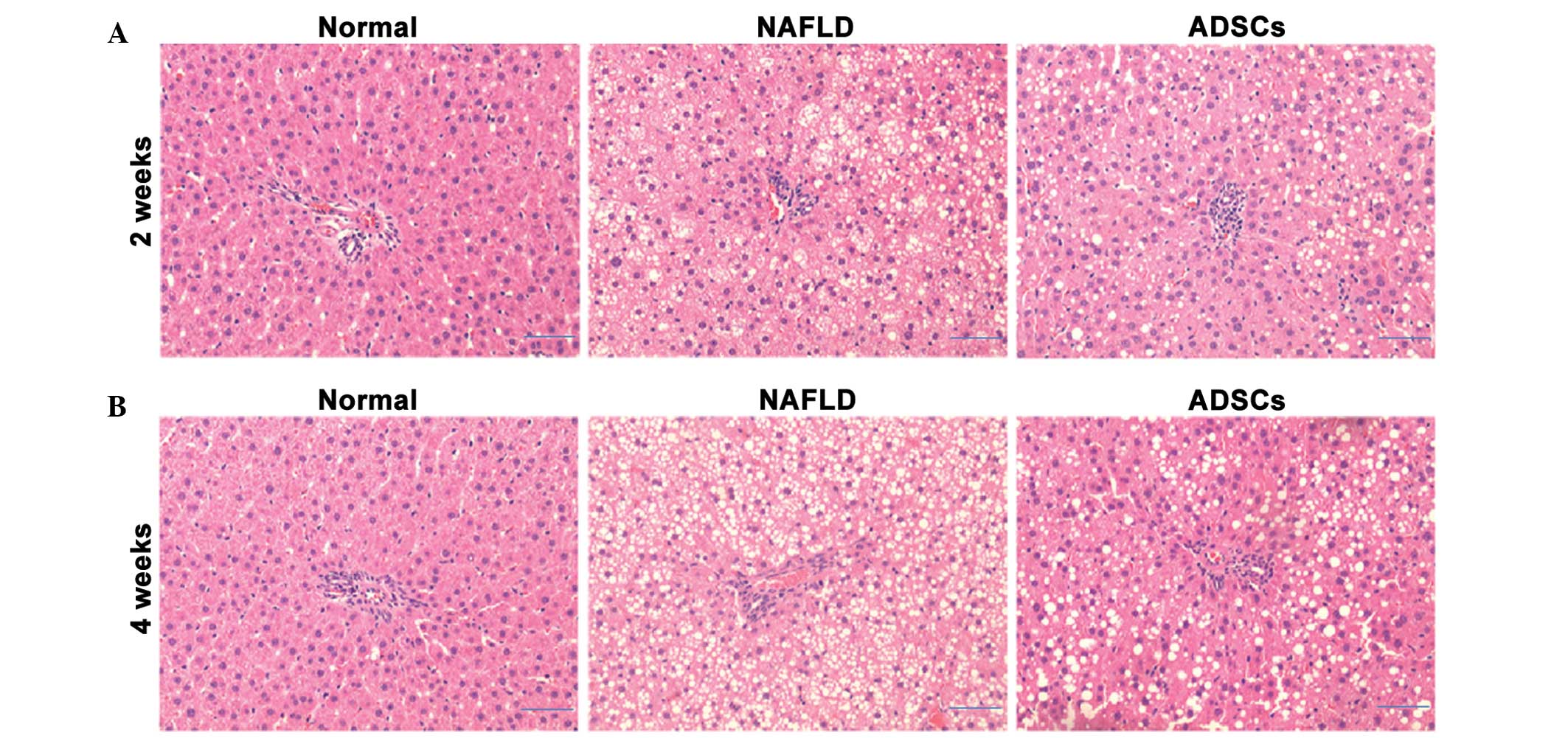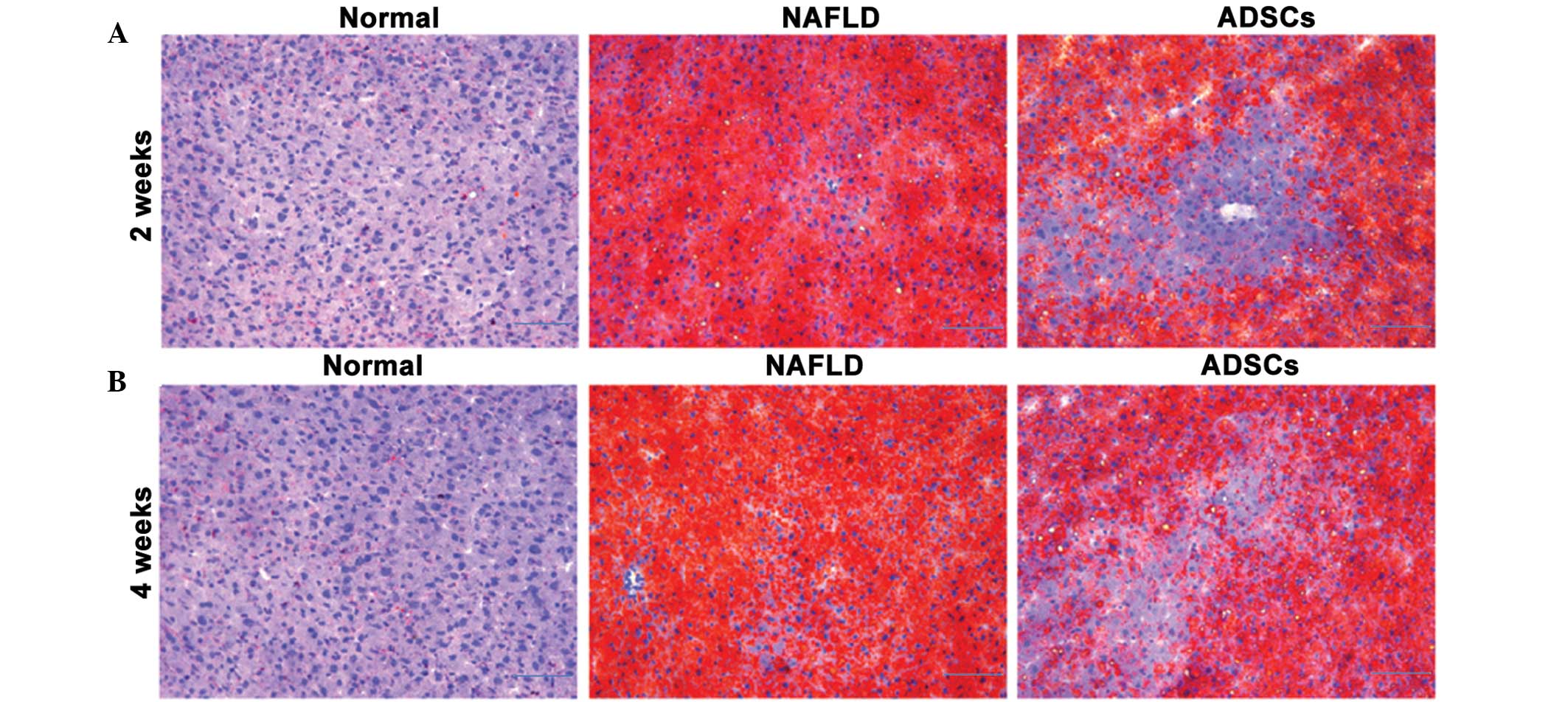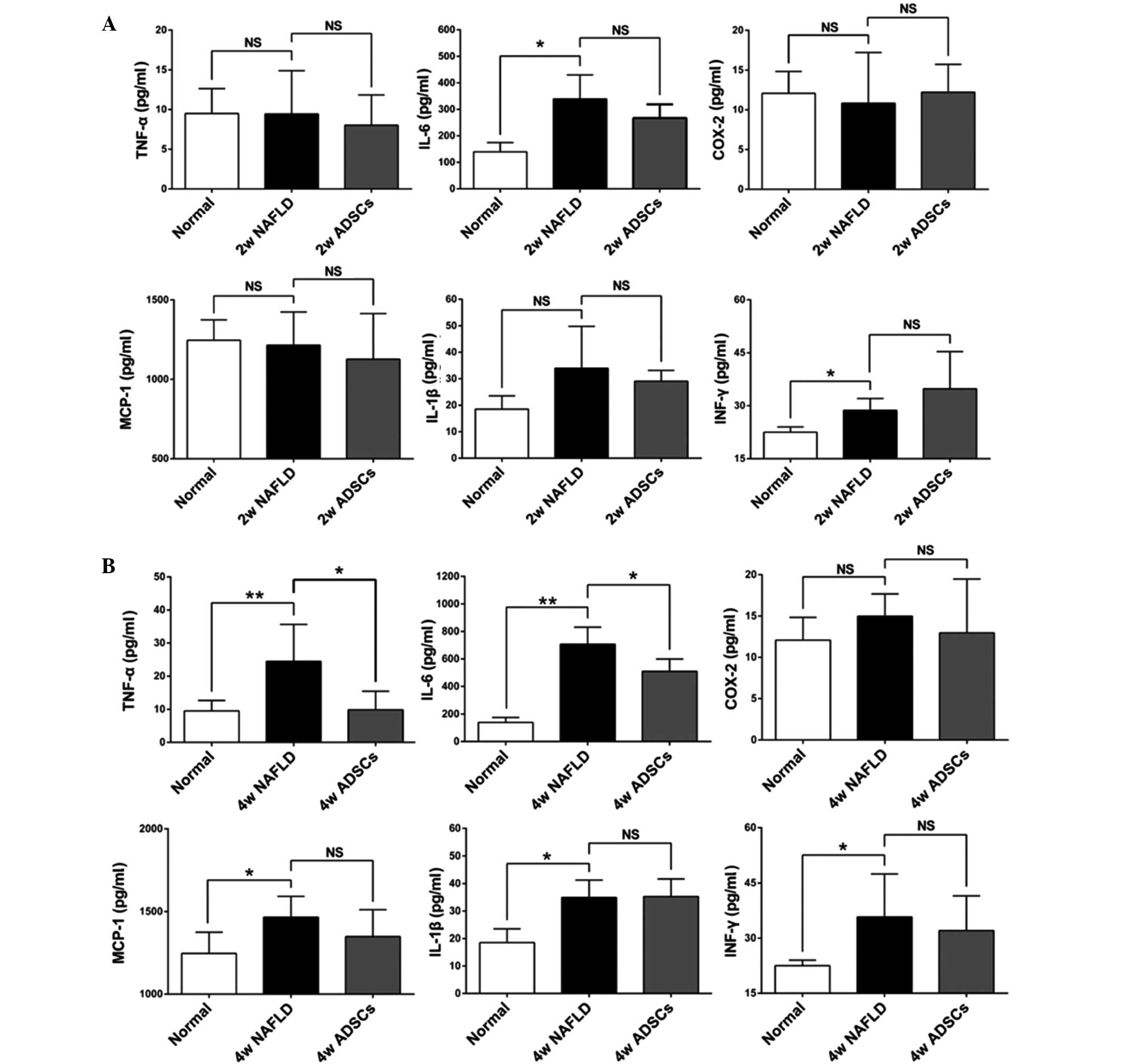Intrahepatic transplantation of adipose‑derived stem cells attenuates the progression of non‑alcoholic fatty liver disease in rats
- Authors:
- Published online on: May 26, 2015 https://doi.org/10.3892/mmr.2015.3847
- Pages: 3725-3733
Abstract
Introduction
Non-alcoholic fatty liver disease (NAFLD) is one of the major causes of chronic liver injury, which affects 10–24% of the general population worldwide (1). The prevalence of NAFLD has markedly increased, which is associated with rates of severe obesity, insulin resistance and other metabolic syndromes (2). The underlying pathogenesis of NAFLD remains to be fully elucidated, however, the pathological changes may be explained by the 'two-hit hypothesis' (3). The 'first hit” consists of the accumulation of hepatic lipids, which is predominantly associated with insulin resistance, while the 'second hit' consists of oxidative stress, mitochondrial dysfunction and inflammation, which may aggravate the existing steatosis and lead to non-alcoholic steatosis hepatitis (NASH) (1,4). At present, there remains no satisfactory therapeutic treatment for NAFLD.
Mesenchymal stem cells (MSCs) possess the ability to differentiate into multiple cells, including adipocytes, osteocytes, hepatocytes, chondrocytes and neurons (5,6), which regulate the immune response and are important in tissue repair, thus attracting attention for potential as a novel therapeutic approach (7,8). Compared with other sources of MSCs, adipose tissue-derived stem cells (ADSCs) have the advantages of being abundant, readily obtainable from liposuction or excised fat and accumulated rapidly for autologous transplantation with minimal immunogenicity and improved immunoregulatory ability (9). These characteristics make ADSCs more attractive for clinical usage in cell-based therapy. Previous studies have demonstrated the immunoregulatory roles of ADSCs in tissue and organ repair (10–12), particularly on the protective effects of ADSCs on acute or chronic liver failure and liver fibrosis (13,14). However, the liver injury model used in these investigations was induced by chemical drug treatments, including tetrachloromethane, d-galactosamine and thioacetamide. Therefore, the underlying mechanisms and the pathological changes observed were different to those observed in the most common liver diseases, including viral-induced (hepatitis B or C) chronic inflammation and fatty liver disease (FLD) (15,16). As one of the most common forms of FLD, NAFLD refers to a series of pathological changes, including hepatic steatosis, NASH, liver fibrosis and cirrhosis, which are not easily mimicked by chemical drug treatment. Administration of a high-fat-diet (HFD) is usually used to establish NAFLD animal models (17), which more closely resembles the clinical pathological progression of NAFLD disease.
In the present study, in order to investigate whether transplantation with ADSCs attenuates disease progression at an early stage of NAFLD, intrahepatic transplantation of ADSCs was performed on an HFD-induced NAFLD rat model, and the liver function and histopathological characteristics of the liver following transplantation were carefully evaluated.
Materials and methods
Animal experiments
A total of 40 adult male Sprague-Dawley rats (weight, 180–200 g) were obtained from the Center for Animal Experiment of Fujian Medical University (Fuzhou, China; license no. SCXKmin 2012–0002) and were housed at constant temperature (22±2°C) and 60% relative humidity, with a 12:12 h light-dark cycle. Rats had ad libitum access to food and autoclaved water. All animal procedures were approved by the Animal Ethics Committee of Fuzhou General Hospital of the Fujian province of China (Fuzhou, China).
Isolation and culture of rat ADSCs
Male Sprague-Dawley rats were anesthetized with 2% pentobarbital sodium (40 mg/kg; wt; i.p.; Merck Chemicals, Shanghai, China), and the adipose tissues (~3×1.5×0.5 cm) were collected by excision from the subcutaneous inguinal region of male Sprague-Dawley rats, and washed thoroughly with phosphate-buffered saline (PBS; GE Healthcare Life Sciences, Logan, UT, USA). Subsequently, the tissues were cut into small sections (~0.1mm3) and digested with 0.1% type I collagenase (Sigma-Aldrich, St. Louis, MO, USA) at 37°C with gentle agitation for 60 min. Subsequently, the type I collagenase activity was neutralized by adding an equal volume (10 ml per rat) of α-modified Eagle's minimum essential medium (α-MEM; GE Healthcare Life Sciences) containing 20% fetal bovine serum (FBS; Gibco Life Technologies, Carlsbad, CA, USA), followed by filtering through an 100 µm cell strainer and centrifugation at 400 × g for 10 min at room temperature. The supernatant containing the lipid droplets was discarded and the cell pellet was washed twice with PBS. The cell pellets containing the erythrocytes were then lysed with osmotic lysates (Biyuntian Biotech Co., Ltd., Shanghai, China). The remaining cells were suspended in the complete medium, consisting of α-MEM, with 20% FBS, supplemented with 1% penicillin/streptomycin (Gibco Life Technologies). Subsequently, the resuspended cells were immediately transferred into 25 cm2 cell culture flasks (Corning Incorporated, Corning, NY, USA) at a density of 1×106 cells/ml, and incubated at 37°C with 5% CO2. The medium was replaced after 24 h and the adherent cells were further expanded with complete medium, which was replaced every 2 days. Once the cells had reached ~80% confluence, they were detached using 0.25% trypsin-0.02% EDTA (Gibco Life Technologies) and passaged at a dilution of 1:3. Cultured cells at the third passage were used for the analysis of cell surface markers and for transplantation into the livers of the NAFLD rats.
Flow cytometry analysis
The surface biomarkers of the ADSCs were characterized using flow cytometry to ensure cell quality. The cultured cells were detached using 0.25% trypsin/0.02% EDTA and were suspended in PBS containing 5% bovine serum albumin (Sigma-Aldrich). Subsequently, the cells were incubated with the following primary antibodies for 60 min at room temperature: PE-conjugated anti-mouse/rat CD29 (monoclonal; 1:200; eBioscience, San Diego, CA, USA; cat. no. 12-0291-82), mouse anti-rat/human CD31 (monoclonal; 1:100; Santa Cruz Biotechnology, Inc., Dallas, TX, USA; cat. no. SC-80913), mouse anti-rat/human CD34 (monoclonal; 1:100; Santa Cruz Biotechnology, Inc.; cat. no. SC-7324), PE-conjugated anti-mouse/rat CD44H (monoclonal; 1:200; eBioscience; cat. no. 12-0444-82), rabbit anti-rat/human/mouse CD45 (polyclonal; 1:100; Santa Cruz Biotechnology, Inc.; cat. no. SC-25590) and rabbit anti-rat/human/mouse CD90 (polyclonal; 1:100; Santa Cruz Biotechnology, Inc.; cat. no. SC-9163). The cells were then washed twice with PBS and further incubated with fluorescent-conjugated secondary antibodies (donkey anti-mouse IgG-Alexa Fluor® 488 (polyclonal, 1:1,000) or donkey anti-rabbit IgG-Alexa Fluor® 647 (polyclonal, 1:1,000), obtained from Invitrogen Life Technologies (Carlsbad, CA, USA; cat. no. A-21202 or A31573) for 30 min at room temperature. Finally, the cells were washed twice with PBS and characterized using a fluorescence-activated cell sorter (FACS; BD Biosciences, Franklin Lakes, NJ, USA). The raw data was further analyzed using FlowJo 7.6 software (FlowJo, LLC, Ashland, OR, USA).
Transplantation of ADSCs into the livers of NAFLD rats
The NAFLD rat model was induced using a previously described procedure (17) with modification. Briefly, the rats were fed either with normal chow (control group) or with a HFD, which contained 88% normal chow, 2% cholesterol and 10% lard, for 6 weeks. Subsequent to the development of hepatic steatosis, the NAFLD rats (n=20) were randomly divided into two groups: The NAFLD group (n=10), treated with PBS (1 ml/rat), as a mock-treatment group; and the ADSCs therapy group (n=10), which received intrahepatic transplantation of ADSCs (2×106 cells/rat). The transplantation was performed as follows: The rats were temporarily anesthetized with diethyl ether (Sinopharm Chemical Reagent Co. Ltd., Shanghai, China), following which the abdominal cavity was opened under aseptic conditions, and the portal vein was exposed using moistened swabs. Subsequently, the suspension of ADSCs in PBS was injected into the portal vein using a 24-gauge needle. All NAFLD rats were continuously fed with HFD and were sacrificed with 2% pentobarbital sodium (100 mg/kg; wt; i.p.) (Merck Chemicals) 2 or 4 weeks after transplantation. The liver tissues (~400mg per rat) and sera (~3 ml per rat) were simultaneously collected for further investigation.
Biochemical assays of liver function
The collected sera was separated by centrifugation at 1,000 × g at 4°C for 10 min, then was stored at −80°C for further use. The serum levels of total cholesterol (TC), triglycerides (TG), fatty acids (FA), alanine aminotransferase (ALT), aspartate aminotransferase (AST) and total bilirubin (TBIL) were measured using TC, TG, FA, ALT, AST and TBIL ELISA kits, respectively, according to the manufacturer's instructions (Nanjing Jiancheng Bioengineering Institute, Nanjing, China).
To further investigate whether ADSC transplantation improved hepatic lipid peroxidation, each liver sample was homogenized in stroke-physiological saline solution (Fuzhou Neptunus Futao Pharmaceuticals Co., Ltd, Fuzhou, China), and was then centrifuged at 5,000 × g for 10 min at 4°C. The supernatants were collected and the activity of liver superoxide dismutase (SOD), and the content of malondialdehyde (MDA) were measured using SOD and MDA assay kits (Nanjing Jiancheng Bioengineering Institute), according to the manufacturer's instructions. The activity of SOD and the MDA content were normalized to the level of total protein, which was measured using a bicinchoninic acid assay kit (Beijing TransGen Biotech Co., Ltd., Beijing, China).
Histopathological assessment
The obtained liver tissues were fixed in 4% paraformaldehyde for 24 h, then were gradually dehydrated with ethanol, embedded in paraffin and stained with hematoxylin and eosin (H&E) staining kit (Jiancheng Bioengineering Institute, Nanjing, China). The presence of hepatic steatosis and inflammation evaluated by two pathologists in a double-blinded manner. To further visualize the accumulation of fat in the liver, oil red O staining was performed using a commercial kit (Nanjing Jiancheng Bioengineering Institute), according to the manufacturer's instructions. The histopathological examination was performed using an Olympus microscope (BX51; Tokyo, Japan).
Assessment of pro-inflammatory cytokines
The secretion levels of tumor necrosis factor (TNF)-α, interleukin (IL)-6, cyclooxygenase (COX)-2, IL-1β, monocyte chemoattractant protein (MCP)-1 and interferon (IFN)-γ in the serum were evaluated using ab ELISA (Shanghai BlueGene Biotech Co., Ltd., Shanghai, China), according to the manufacturer's instructions. Briefly, the standards and samples were added to an antibody-coated 96-well plate, incubated at 37°C for 1 h and, followed with double-distilled water 3 times, the substrate was then added to each well at 37°C for 10 min. Absorbance values were measured at 450 nm using a SpectraMax M5e microplate reader (Molecular Devices, LLC, Sunnyvale, CA, USA).
Statistical analyses
GraphPad Prism, version 6.00 (GraphPad Software, Inc., La Jolla, CA, USA) for Windows was used for statistics analysis. All quantitative data are expressed as the mean ± standard deviation. Statistical analysis among different groups was performed using Student's t-test. P<0.05 was considered to indicate a statistically significant difference.
Results
Characterization of rat ADSCs
The derived ADSCs were first characterized by their fibroblast-like morphology, which is consistent with the morphological characteristics of ADSCs from other species (Fig. 1A) (13). Subsequently, the specific surface biomarkers of ADSCs were characterized using fluorescence-activated cell sorting, in which CD29 (99.8%), CD44 (99.4%) and CD90 (99.0%) were positively expressed, CD45 (17.2%) was moderately expressed, and CD31 (1.93%) and CD34 (1.47%) were negatively expressed (Fig. 1B). This expression pattern of the surface biomarkers was consistent with that reported for characterization of ADSCs (14). Therefore, the derived cells were deemed suitable for further transplantation experiments.
ADSC transplantation improves the hepatic functions of NAFLD model rats
To confirm whether transplantation of ADSCs was able to attenuate hepatic injuries, serum levels of ALT, AST and TBIL, which are associated with liver function, were measured 2 or 4 weeks following ADSC therapy. As shown in Fig. 2, the serum levels of ALT and TBIL in the NAFLD rats were significantly higher following 2 weeks of further feeding with an HFD (8 weeks HFD in total), compared with the normal rats, however, the AST level was not significantly different. On further feeding of NAFLD rats with HFD for 4 weeks (10 weeks HFD in total), the serum levels of ALT, TBIL and AST were significantly higher, compared with the normal rats, indicating severe damage to the liver function of NAFLD rats. At 2 weeks post-ADSC transplantation into the NAFLD rats, the serum levels of ALT, TBIL and AST were all significantly reduced, almost to the levels observed in the normal rats, which demonstrated that transplantation with ADSCs protected the liver function against damage. However, only ALT remained significantly lower 4 weeks after ADSC transplantation, compared with the NAFLD rats. The levels of TBIL and AST were no longer significantly different compared with the NAFLD rats, possibly due to the continuous HFD feeding during the treatment of all rats.
Transplantation with ADSCs promotes lipid metabolism in NAFLD rats
Disorder of lipid metabolism is the predominant biochemical change in the development of NAFLD (1). To determine whether ADSC transplantation promoted the lipid metabolism in the livers of NAFLD rats, the serum levels of TC, TG and FA were measured 2 or 4 weeks after transplantation with the ADSCs. As shown in Fig. 3, higher levels of TC, TG and FA were observed in the NAFLD rats, compared with the normal rats, which indicated that the NAFLD rats had imbalanced lipid metabolism. At 2 weeks post-ADSC transplantation in the NAFLD rats, the serum levels of TC and TG were significantly reduced, while the serum level of FA was not significantly reduced, compared with the NAFLD rats. However, at 4 weeks post-ADSC transplantation, the serum levels of TC, TG and FA were all significantly lower than those in the NAFLD rats, suggesting that the transplanted ADSCs promoted lipid metabolism.
Transplantation with ADSCs reduces oxidative stress in the liver tissues
To further examine the effect of ADSC transplantation on oxidative stress in the livers of NAFLD rats, the SOD activity and MDA content in the liver homogenates were evaluated. As shown in Fig. 4, the activity of SOD and MDA content in the NAFLD rats, which received another 2 weeks HFD feeding (8 weeks HFD in total) were not significantly different, compared with the normal rats. However, the SOD activity was significantly reduced and the MDA content was significantly increased in the NAFLD rats, which received another 4 weeks HFD feeding (10 weeks HFD in total), compared with the normal rats, indicating that oxidative stress was induced in the NAFLD rats. At 2 weeks post-ADSC transplantation in the NAFLD rats, the SOD activity and MDA content were not significantly altered. However, the SOD activity was significantly higher and the MDA content was significantly lower, compared with the NAFLD rats, at 4 weeks post-ADSC transplantation. These results suggested that ADSC transplantation reduces oxidative stress in the liver.
ADSCs transplantation decelerates hepatic pathological changes in NAFLD rats
Hepatic histopathological assessment is the gold standard for NAFLD diagnosis (18). In order to determine whether transplantation with ADSCs has a protective role by slowing pathological progression, the liver tissues were evaluated following H&E staining. As shown in Fig. 5, no evidence of steatosis or inflammation was identified in the liver tissues of the normal group. Following HFD feeding, the NAFLD group exhibited typical steatosis, indicating that the NAFLD model was successfully established. However, evidence of steatosis was limited 2 weeks post-ADSC transplantation, and low gradesteatosis was observed 4 weeks post-ADSC transplantation, which indicated that the ADSCs attenuated the development of NAFLD.
The excessive accumulation of hepatic lipids is the major pathological feature in the progression of NAFLD (19). To further confirm whether transplantation with ADSCs reduced lipid accumulation in the liver tissues, the hepatic lipid contents were evaluated using oil red O staining. As shown in Fig. 6, no lipid accumulation was observed in the normal rats, however, numerous lipids were observed in the liver tissues of the NAFLD rats. The ADSC group exhibited lower lipid accumulation, compared with the NAFLD rats, suggesting that the ADSCs reduced lipid accumulation in the livers of NAFLD rats, thus decelerating disease progression.
ADSC transplantation selectively reduces the serum levels of TNF-α and IL-6 in NAFLD rats
Inflammation is important in the pathogenesis of hepatic steatosis to NASH. To further assess whether transplantation with ADSCs had an immunoregulatory role by reducing the secretion of pro-inflammatory cytokines, the serum levels of TNF-α, IL-6, COX-2, IL-1β, MCP-1 and IFN-γ were detected by ELISA. As shown in Fig. 7, the serum levels of IL-6 and IFN-γ were significantly increased in the NAFLD rats, which received another 2 weeks HFD feeding (8 weeks HFD in total), while no significant differences were observed in the other cytokines between this group and the normal rats. This indicated that the rat livers were not undergoing inflammation. However, following 4 weeks HFD feeding of the NAFLD rats (10 weeks HFD in total), the serum levels of TNF-α, IL-6, IL-1β, MCP-1 and IFN-γ were all significantly increased, with no significant change in COX-2 levels, compared with the normal rats. These data suggested that the rat livers were undergoing inflammation. At 2 weeks post-ADSC transplantation, none of the measured cytokines were significantly different, compared with the NAFLD rats, due to the fact that inflammation was not present in the rat livers. Notably, the serum levels of IL-6 and TNF-α, which are predominantly secreted by the kuffer cells in the liver and actively contribute to the acute inflammatory responses (20,21), were significantly reduced at 4 weeks post-ADSC transplantation, compared with the NAFLD rats, although no significant changes were observed in the other cytokines measured,. Taken together, these results demonstrated that ADSC transplantation selectively reduced the secretion of pro-inflammatory cytokines, including TNF-α and IL-6, attenuating the progression of NAFLD.
Discussion
MSC transplantation is being investigated as an alternative therapeutic approach for liver transplantation in chronic liver diseases (22). Previous studies have demonstrated that multi-potent stromal cells and the hepatocyte-like cells from bone marrow-derived stem cells may offer a potential solution to prevent the progression of NAFLD in animal models (23,24). However, whether ADSCs have a therapeutic effect on NAFLD remains to be fully elucidated. In the present study, ADSCs were able to efficiently protect the NAFLD rats from disease progression, which suggested that ADSC transplantation may be an effective therapeutic approach for NAFLD.
According to the 'two-hit' hypothesis, the 'first hit' is marked by the accumulation of hepatic lipids, but not due to the alcohol abuse (1,4,25), following which liver function is damaged. In the present study, transplantation with ADSCs improved liver function through reductions in ALT activity and total TBIL (Fig. 2), in addition to promoting lipid metabolism (Fig. 3). These observations were consistent with the hepatic pathological morphological changes in the H&E (Fig. 5) and oil red O staining (Fig. 6), confirming that ADSCs attenuated the disease progression of NAFLD.
Under pathological conditions, excessive lipid accumulations can cause damage via peroxidation, resulting in the occurrence of marked oxidative stress (26–28). In the present study, transplantation with ADSCs reduced oxidative stress by increasing the activity of SOD and reducing the content of MDA (Fig. 4), which may result from the suppression of lipid peroxidation by ADSC transplantation.
It has been demonstrated that inflammation is important in the progression of NAFLD (26,29,30). In the present study, high levels of pro-inflammatory cytokines, including IL-6, TNF-α, IL-1β, MCP-1 and IFN-γ were observed in the NAFLD rats, which suggested that inflammation was induced in the model. However, the secretions of IL-6 and TNF-α, which are considered to be major inflammatory mediators of steatosis, insulin resistance and associated inflammatory disorders (31,32), were significantly inhibited following ADSC transplantation. These results suggested that ADSC transplantation selectively inhibited inflammation, mediated by IL-6 and TNF-α. Notably, the level of COX-2 was not increased in the NAFLD rats, compared with the normal rats, which may be due to the possibility that the animal model had not progressed to NASH, as significant increases in COX-2 are reported to appear only in the NASH stage (33,34).
Certain key parameters, including serum TBIL and AST were only reduced 2 weeks after transplantation with ADSCs, however, these changes were not observed 4 weeks after transplantation. This may be due to continued HFD feeding attenuating the therapeutic effects of ADSC transplantation. To more effectively prevent NAFLD progression, intrahepatic transplantation may be combined with multiple supplementary injections of ADSCs via the tail or penis vein, to further maintain the therapeutic effects.
ADSCs may be more suitable for clinical use due to the advantages of being abundant, readily maintained, highly proliferative and exhibiting improved immunoregulatory activities (9,35), however, further investigation into the possible tumorigenic risk are to be performed prior to clinical application. In the present study, the application of ADSC transplantation reduced the rate of disease progression in the NAFLD rat model. The results demonstrated that ADSC transplantation significantly improved liver function, reduced lipid accumulation and attenuated the inflammatory state of the liver, therefore decelerating the progression of NAFLD in the rat model. In conclusion, ADSC transplantation may offer a promising therapeutic approach for the treatment of NAFLD in the future.
Acknowledgments
This study was supported by the National Natural Science Foundation of China (grant no. 31201008), the Scientific Foundation of Fuzhou Health Department (grant no. 2013-S-wq15), the Research Development Foundation of Fujian Medical University (grant no. FZS13001Y), the Key Medical Foundation of Nanjing Military Command of China (grant no. 14ZX22), the National Natural Science Foundation of Fujian Province of China (grant no. 2012J01407), the Research Development Foundation of Fuzhou General Hospital of Fujian Province of China (grant no. 2014J08) and the University Natural Science Foundation of Jiangsu Province (grant no. 12KJB180013).
References
|
Ibrahim MA, Kelleni M and Geddawy A: Nonalcoholic fatty liver disease: Current and potential therapies. Life Sci. 92:114–118. 2013. View Article : Google Scholar | |
|
Henao-Mejia J, Elinav E, Jin C, Hao L, Mehal WZ, Strowig T, Thaiss CA, Kau AL, Eisenbarth SC, Jurczak MJ, et al: Inflammasome-mediated dysbiosis regulates progression of NAFLD and obesity. Nature. 482:179–185. 2012.PubMed/NCBI | |
|
Rezazadeh A, Yazdanparast R and Molaei M: Amelioration of diet-induced nonalcoholic steatohepatitis in rats by Mnsalen complexes via reduction of oxidative stress. J Biomed Sci. 19:262012. View Article : Google Scholar | |
|
Shaker M, Tabbaa A, Albeldawi M and Alkhouri N: Liver transplantation for nonalcoholic fatty liver disease: New challenges and new opportunities. World J Gastroenterol. 20:5320–5330. 2014. View Article : Google Scholar : PubMed/NCBI | |
|
Nagaishi K, Ataka K, Echizen E, Arimura Y and Fujimiya M: Mesenchymal stem cell therapy ameliorates diabetic hepatocyte damage in mice by inhibiting infiltration of bone marrow-derived cells. Hepatology. 59:1816–1829. 2014. View Article : Google Scholar : PubMed/NCBI | |
|
Banas A, Teratani T, Yamamoto Y, Tokuhara M, Takeshita F, Quinn G, Okochi H and Ochiya T: Adipose tissue-derived mesenchymal stem cells as a source of human hepatocytes. Hepatology. 46:219–228. 2007. View Article : Google Scholar : PubMed/NCBI | |
|
Kubo N, Narumi S, Kijima H, Mizukami H, Yagihashi S, Hakamada K and Nakane A: Efficacy of adipose tissue-derived mesenchymal stem cells for fulminant hepatitis in mice induced by concanavalin A. J Gastroenterol Hepatol. 27:165–172. 2012. View Article : Google Scholar | |
|
Ghannam S, Bouffi C, Djouad F, Jorgensen C and Noël D: Immunosuppression by mesenchymal stem cells: Mechanisms and clinical applications. Stem Cell Res Ther. 1:22010. View Article : Google Scholar : PubMed/NCBI | |
|
Sun CK, Chang CL, Lin YC, Kao YH, Chang LT, Yen CH, Shao PL, Chen CH, Leu S and Yip HK: Systemic administration of autologous adipose-derived mesenchymal stem cells alleviates hepatic ischemia-reperfusion injury in rats. Crit Care Med. 40:1279–1290. 2012. View Article : Google Scholar : PubMed/NCBI | |
|
Meyerrose TE, De Ugarte DA, Hofling AA, Herrbrich PE, Cordonnier TD, Shultz LD, Eagon JC, Wirthlin L, Sands MS, Hedrick MA, et al: In vivo distribution of human adipose-derived mesenchymal stem cells in novel xenotransplantation models. Stem Cells. 25:220–227. 2007. View Article : Google Scholar | |
|
Philippe B, Luc S, Valérie PB, Jérôme R, Alessandra BR and Louis C: Culture and use of mesenchymal stromal cells in phase I and II clinical trials. Stem Cells Int. 2010:5035932010. View Article : Google Scholar : PubMed/NCBI | |
|
Zhang Y, Chen XM and Sun DL: Effects of coencapsulation of hepatocytes with adipose-derived stem cells in the treatment of rats with acute-on-chronic liver failure. Int J Artif Organs. 37:133–141. 2014. View Article : Google Scholar : PubMed/NCBI | |
|
Saito Y, Shimada M, Utsunomiya T, Ikemoto T, Yamada S, Morine Y, Imura S, Mori H, Sugimoto K, Iwahashi S, et al: The protective effect of adipose-derived stem cells against liver injury by trophic molecules. J Surg Res. 180:162–168. 2013. View Article : Google Scholar | |
|
Harn HJ, Lin SZ, Hung SH, Subeq YM, Li YS, Syu WS, Ding DC, Lee RP, Hsieh DK, Lin PC, et al: Adipose-derived stem cells can abrogate chemical-induced liver fibrosis and facilitate recovery of liver function. Cell Transplant. 21:2753–2764. 2012. View Article : Google Scholar : PubMed/NCBI | |
|
Liedtke C, Luedde T, Sauerbruch T, Scholten D, Streetz K, Tacke F, Tolba R, Trautwein C, Trebicka J and Weiskirchen R: Experimental liver fibrosis research: Update on animal models, legal issues and translational aspects. Fibrogenesis Tissue Repair. 6:192013. View Article : Google Scholar : PubMed/NCBI | |
|
Nanji AA and French SW: Animal models of alcoholic liver disease - focus on the intragastric feeding model. Alcohol Res Health. 27:325–330. 2003. | |
|
Seki A, Sakai Y, Komura T, Nasti A, Yoshida K, Higashimoto M, Honda M, Usui S, Takamura M, Takamura T, et al: Adipose tissue-derived stem cells as a regenerative therapy for a mouse steatohepatitis-induced cirrhosis model. Hepatology. 58:1133–1142. 2013. View Article : Google Scholar : PubMed/NCBI | |
|
Vernon G, Baranova A and Younossi ZM: Systematic review: The epidemiology and natural history of non-alcoholic fatty liver disease and non-alcoholic steatohepatitis in adults. Aliment Pharmacol Ther. 34:274–285. 2011. View Article : Google Scholar : PubMed/NCBI | |
|
Milagro FI, Campión J and Martínez JA: Weight gain induced by high-fat feeding involves increased liver oxidative stress. Obesity (Silver Spring). 14:1118–1123. 2006. View Article : Google Scholar | |
|
Stauffer JK, Scarzello AJ, Jiang Q and Wiltrout RH: Chronic inflammation, immune escape, and oncogenesis in the liver: A unique neighborhood for novel intersections. Hepatology. 56:1567–1574. 2012. View Article : Google Scholar : PubMed/NCBI | |
|
Budhu A and Wang XW: The role of cytokines in hepatocellular carcinoma. J Leukoc Biol. 80:1197–1213. 2006. View Article : Google Scholar : PubMed/NCBI | |
|
Wang Y, Lian F, Li J, Fan W, Xu H, Yang X, Liang L, Chen W and Yang J: Adipose derived mesenchymal stem cells transplantation via portal vein improves microcirculation and ameliorates liver fibrosis induced by CCl4 in rats. J Transl Med. 10:1332012. View Article : Google Scholar : PubMed/NCBI | |
|
Ezquer M, Ezquer F, Ricca M, Allers C and Conget P: Intravenous administration of multipotent stromal cells prevents the onset of non-alcoholic steatohepatitis in obese mice with metabolic syndrome. J Hepatol. 55:1112–1120. 2011. View Article : Google Scholar : PubMed/NCBI | |
|
Winkler S, Borkham-Kamphorst E, Stock P, Brückner S, Dollinger M, Weiskirchen R and Christ B: Human mesenchymal stem cells towards non-alcoholic steatohepatitis in an immunodeficient mouse model. Exp Cell Res. 326:230–239. 2014. View Article : Google Scholar : PubMed/NCBI | |
|
Gaggini M, Morelli M, Buzzigoli E, DeFronzo RA, Bugianesi E and Gastaldelli A: Non-alcoholic fatty liver disease (NAFLD) and its connection with insulin resistance, dyslipidemia, atherosclerosis and coronary heart disease. Nutrients. 5:1544–1560. 2013. View Article : Google Scholar : PubMed/NCBI | |
|
Takaki A, Kawai D and Yamamoto K: Molecular mechanisms and new treatment strategies for non-alcoholic steatohepatitis (NASH). Int J Mol Sci. 15:7352–7379. 2014. View Article : Google Scholar : PubMed/NCBI | |
|
Mollica MP, Lionetti L, Moreno M, Lombardi A, De Lange P, Antonelli A, Lanni A, Cavaliere G, Barletta A and Goglia F: 3,5-diiodo-l-thyronine, by modulating mitochondrial functions, reverses hepatic fat accumulation in rats fed a high-fat diet. J Hepatol. 51:363–370. 2009. View Article : Google Scholar : PubMed/NCBI | |
|
Zou Y, Li J, Lu C, Wang J, Ge J, Huang Y, Zhang L and Wang Y: High-fat emulsion-induced rat model of nonalcoholic steatohepatitis. Life Sci. 79:1100–1107. 2006. View Article : Google Scholar : PubMed/NCBI | |
|
Asrih M and Jornayvaz FR: Inflammation as a potential link between nonalcoholic fatty liver disease and insulin resistance. J Endocrinol. 218:R25–R36. 2013. View Article : Google Scholar : PubMed/NCBI | |
|
Del Ben M, Polimeni L, Carnevale R, Bartimoccia S, Nocella C, Baratta F, Loffredo L, Pignatelli P, Violi F and Angelico F: NOX2-generated oxidative stress is associated with severity of ultrasound liver steatosis in patients with non-alcoholic fatty liver disease. BMC Gastroenterol. 14:812014. View Article : Google Scholar : PubMed/NCBI | |
|
Meli R, MattaceRaso G and Calignano A: Role of Innate Immune Response in Non-Alcoholic Fatty Liver Disease: Metabolic Complications and TherapeuticTools. Front Immunol. 5:1772014. View Article : Google Scholar | |
|
Jung UJ and Choi MS: Obesity and its metabolic complications: The role of adipokines and the relationship between obesity, inflammation, insulin resistance, dyslipidemia and nonalcoholic fatty liver disease. Int J Mol Sci. 15:6184–6223. 2014. View Article : Google Scholar : PubMed/NCBI | |
|
Chen J, Liu D, Bai Q, Song J, Guan J, Gao J, Liu B, Ma X and Du Y: Celecoxib attenuates liver steatosis and inflammation in non-alcoholic steatohepatitis induced by high-fat diet in rats. Mol Med Rep. 4:811–816. 2011.PubMed/NCBI | |
|
Giannitrapani L, Ingrao S, Soresi M, Florena AM, La Spada E, Sandonato L, D'Alessandro N, Cervello M and Montalto G: Cyclooxygenase-2 expression in chronic liver diseases and hepatocellular carcinoma: An immunohistochemical study. Ann N Y Acad Sci. 1155:293–299. 2009. View Article : Google Scholar : PubMed/NCBI | |
|
Seki T, Yokoyama Y, Nagasaki H, Kokuryo T and Nagino M: Adipose tissue-derived mesenchymal stem cell transplantation promotes hepatic regeneration after hepatic ischemia-reperfusion and subsequent hepatectomy in rats. J Surg Res. 178:63–70. 2012. View Article : Google Scholar : PubMed/NCBI |



